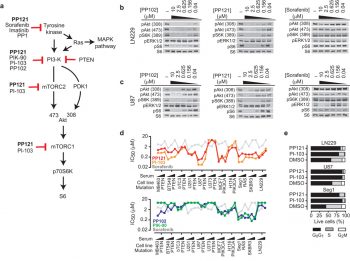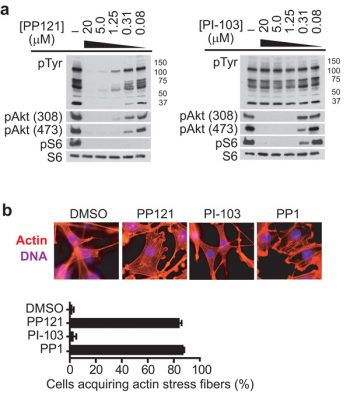
| Size | Price | Stock | Qty |
|---|---|---|---|
| 5mg |
|
||
| 10mg |
|
||
| 25mg |
|
||
| 50mg |
|
||
| 100mg |
|
||
| 250mg |
|
||
| 500mg |
|
||
| 1g |
|
||
| Other Sizes |
|
Purity: ≥98%
PP-121 is a novel, potent and selective multi-targeted RTK (receptor tyrosine kinases) inhibitor that may have antitumor effects. It blocks a number of kinases, including DNA-PK, PDGFR, Hck, mTOR, VEGFR2, Src, and Abl, with respective IC50 values of 60 nM, 2 nM, 8 nM, 10 nM, 12 nM, and 18 nM. In vitro tests revealed strong antiproliferative activity, and in vivo tests revealed high antitumor efficacy.
| Targets |
VEGFR2 (IC50 = 12 nM); PDGFR (IC50 = 2 nM); mTOR (IC50 = 10 nM); DNK-PK (IC50 = 60 nM); Src (IC50 = 14 nM)
|
|---|---|
| ln Vitro |
PP121 blocks the PI3K pathway by direct inhibition of PI3K/mTOR in two glioblastoma cell lines, U87 and LN229. A wide range of tumor cell lines with mutations in the PI3-K pathway members PIK3CA, PTEN, or RAS are effectively inhibited from proliferating by PP121. Most tumor cells are put into a G0G1 arrest by PP121. Src is directly inhibited by PP121 in cells, which also reverses the biochemical and morphological effects of Src. In vitro, PP121 effectively inhibits the Ret kinase domain (IC50<1 nM). The PI3-K and MAPK pathways are effectively blocked by PP121 when they are activated by VEGF. The fact that PP121 directly targets VEGFR2 in cells is supported by the fact that it inhibits VEGFR2 autophosphorylation at low nanomolar concentrations. In K562 cells and BaF3 cells that express Bcr-Abl, PP121 inhibits Bcr-Abl-induced tyrosine phosphorylation[1].
|
| ln Vivo |
Eca-109 xenograft growth is markedly inhibited by oral administration of PP121. PP121 or the vehicle treatment have no discernible impact on the body weights of mice. In xenograft tumors, oral administration of PP121 significantly reduces Akt-mTOR and NFkB activations. The administration of PP121 inhibits both p-IKKa/b and p-Akt Ser 473[2].
|
| Enzyme Assay |
Purified kinase domains are incubated with inhibitors (PP121) at 2- or 4-fold dilutions over a concentration range of 50- 0.001 M, or with a vehicle (0.1% DMSO), in the presence of 10 µM ATP, 2.5 µCi of γ- 32P-ATP, and substrate. Depending on the substrate, reactions are stopped by dotting onto nitrocellulose or phosphocellulose membranes. This membrane is then dried after being washed 5–6 times to remove any radioactivity that wasn't bound to it. Prism software is used to quantify transferred radioactivity through phosphorimaging, and IC50 values are generated by fitting the data to a sigmoidal dose-response curve[1].
|
| Cell Assay |
PP121 is applied to cells grown in 96-well plates at 4-fold dilutions (10 µM - 0.040 µM) or vehicle (0.1% DMSO). Cells are exposed to Resazurin sodium salt (22 µM) after 72 hours, and fluorescence is measured. Values for IC50 are computed. Non-adherent cells are plated at low density (3-5% confluence) and treated with drug (2.5 µM) or vehicle (0.1% DMSO) for proliferation assays involving single cell counting. Every day, cells are diluted in trypan blue and counted using a hemocytometer[1].
|
| Animal Protocol |
Mice: Eca-109 cells are injected into the axillary regions of nude mice (5×106 cells/mouse). When the tumor volumes reach around 200 mm3, the mice are randomly separated to three groups: Untreated control, PP121 (30 mg/kg) and vehicle (10% 1-methyl-2-pyrrolidinone and 90% PEG 300) group. Tumor volumes and the mice body weights are measured every 10 d[2].
|
| References |
|
| Additional Infomation |
PP121 is a pyrazolopyrimidine that is 1H-pyrazolo[3,4-d]pyrimidine which is substituted by a cyclopentyl, 1H-pyrrolo[2,3-b]pyridin-5-yl, and amino groups at positions 1, 3 and 4, respectively. It is a dual inhibitor of tyrosine and phosphoinositide kinases and exhibits anti-cancer properties. It has a role as an EC 2.7.1.137 (phosphatidylinositol 3-kinase) inhibitor, a tyrosine kinase inhibitor and an antineoplastic agent. It is a pyrazolopyrimidine, a pyrrolopyridine, a member of cyclopentanes and an aromatic amine.
The clinical success of multitargeted kinase inhibitors has stimulated efforts to identify promiscuous drugs with optimal selectivity profiles. It remains unclear to what extent such drugs can be rationally designed, particularly for combinations of targets that are structurally divergent. Here we report the systematic discovery of molecules that potently inhibit both tyrosine kinases and phosphatidylinositol-3-OH kinases, two protein families that are among the most intensely pursued cancer drug targets. Through iterative chemical synthesis, X-ray crystallography and kinome-level biochemical profiling, we identified compounds that inhibit a spectrum of new target combinations in these two families. Crystal structures revealed that the dual selectivity of these molecules is controlled by a hydrophobic pocket conserved in both enzyme classes and accessible through a rotatable bond in the drug skeleton. We show that one compound, PP121, blocks the proliferation of tumor cells by direct inhibition of oncogenic tyrosine kinases and phosphatidylinositol-3-OH kinases. These molecules demonstrate the feasibility of accessing a chemical space that intersects two families of oncogenes.[1] Here we explored the potential effect of PP121, a novel dual inhibitor of tyrosine and phosphoinositide kinases, against human esophageal cancer cells. We showed that PP121 exerted potent cytotoxic effect in primary (patient-derived) and established (Eca-109, TE-1 and TE-3 lines) esophageal cancer cells, possibly through activating caspase-3-dependnent apoptosis. PP121 was, however, non-cytotoxic to the normal human esophageal epithelial cells (EECs). At the molecular level, we showed that PP121 blocked Akt-mTOR (mammalian target of rapamycin) activation in esophageal cancer cells, which was restored by introducing a constitutively-active Akt (CA-Akt). Yet, CA-Akt only partly inhibited cytotoxicity by PP121 in Eca-109 cells. Importantly, we showed that PP121 inhibited nuclear factor kappa B (NFκB) signaling activation in esophageal cancer cells, which appeared independent of Akt-mTOR blockage. In vivo, oral administration of PP121 remarkably inhibited Eca-109 xenograft growth in nude mice, and significantly improved mice survival. Further, the immunohistochemistry (IHC) and Western blot assays analyzing xenografted tumors showed that PP121 inhibited Akt-mTOR and NFκB activations in vivo. Together, we demonstrate that PP121 potently inhibits esophageal cancer cells in vitro and in vivo, possibly through concurrently inhibiting Akt-mTOR and NFκB signalings.[2] |
| Molecular Formula |
C17H17N7
|
|---|---|
| Molecular Weight |
319.36378
|
| Exact Mass |
319.154
|
| Elemental Analysis |
C, 63.93; H, 5.37; N, 30.70
|
| CAS # |
1092788-83-4
|
| Related CAS # |
1092788-83-4
|
| PubChem CID |
24905142
|
| Appearance |
White to off-white solid powder
|
| Density |
1.63
|
| Boiling Point |
650.9±50.0 °C at 760 mmHg
|
| Flash Point |
347.4±30.1 °C
|
| Vapour Pressure |
0.0±1.9 mmHg at 25°C
|
| Index of Refraction |
1.881
|
| LogP |
2.41
|
| Hydrogen Bond Donor Count |
2
|
| Hydrogen Bond Acceptor Count |
5
|
| Rotatable Bond Count |
2
|
| Heavy Atom Count |
24
|
| Complexity |
454
|
| Defined Atom Stereocenter Count |
0
|
| SMILES |
NC1=C2C(C3=CC4=C(N=C3)NC=C4)=NN(C2=NC=N1)C5CCCC5
|
| InChi Key |
NVRXTLZYXZNATH-UHFFFAOYSA-N
|
| InChi Code |
InChI=1S/C17H17N7/c18-15-13-14(11-7-10-5-6-19-16(10)20-8-11)23-24(12-3-1-2-4-12)17(13)22-9-21-15/h5-9,12H,1-4H2,(H,19,20)(H2,18,21,22)
|
| Chemical Name |
1-cyclopentyl-3-(1H-pyrrolo[2,3-b]pyridin-5-yl)pyrazolo[3,4-d]pyrimidin-4-amine
|
| Synonyms |
PP121; PP-121; PP121; 1092788-83-4; 1-cyclopentyl-3-(1H-pyrrolo[2,3-b]pyridin-5-yl)-1H-pyrazolo[3,4-d]pyrimidin-4-amine; 1-cyclopentyl-3-(1H-pyrrolo[2,3-b]pyridin-5-yl)pyrazolo[3,4-d]pyrimidin-4-amine; CHEBI:50915; 5B9VB06146; PP 121
|
| HS Tariff Code |
2934.99.9001
|
| Storage |
Powder -20°C 3 years 4°C 2 years In solvent -80°C 6 months -20°C 1 month |
| Shipping Condition |
Room temperature (This product is stable at ambient temperature for a few days during ordinary shipping and time spent in Customs)
|
| Solubility (In Vitro) |
DMSO: ~64 mg/mL (~200.4 mM)
Water: <1 mg/mL Ethanol: ~2 mg/mL (~6.3 mM) |
|---|---|
| Solubility (In Vivo) |
Solubility in Formulation 1: ≥ 2 mg/mL (6.26 mM) (saturation unknown) in 10% DMSO + 40% PEG300 + 5% Tween80 + 45% Saline (add these co-solvents sequentially from left to right, and one by one), clear solution.
For example, if 1 mL of working solution is to be prepared, you can add 100 μL of 20.0 mg/mL clear DMSO stock solution to 400 μL PEG300 and mix evenly; then add 50 μL Tween-80 to the above solution and mix evenly; then add 450 μL normal saline to adjust the volume to 1 mL. Preparation of saline: Dissolve 0.9 g of sodium chloride in 100 mL ddH₂ O to obtain a clear solution. Solubility in Formulation 2: ≥ 2 mg/mL (6.26 mM) (saturation unknown) in 10% DMSO + 90% (20% SBE-β-CD in Saline) (add these co-solvents sequentially from left to right, and one by one), clear solution. For example, if 1 mL of working solution is to be prepared, you can add 100 μL of 20.0 mg/mL clear DMSO stock solution to 900 μL of 20% SBE-β-CD physiological saline solution and mix evenly. Preparation of 20% SBE-β-CD in Saline (4°C,1 week): Dissolve 2 g SBE-β-CD in 10 mL saline to obtain a clear solution. View More
Solubility in Formulation 3: ≥ 2 mg/mL (6.26 mM) (saturation unknown) in 10% DMSO + 90% Corn Oil (add these co-solvents sequentially from left to right, and one by one), clear solution. |
| Preparing Stock Solutions | 1 mg | 5 mg | 10 mg | |
| 1 mM | 3.1313 mL | 15.6563 mL | 31.3126 mL | |
| 5 mM | 0.6263 mL | 3.1313 mL | 6.2625 mL | |
| 10 mM | 0.3131 mL | 1.5656 mL | 3.1313 mL |
*Note: Please select an appropriate solvent for the preparation of stock solution based on your experiment needs. For most products, DMSO can be used for preparing stock solutions (e.g. 5 mM, 10 mM, or 20 mM concentration); some products with high aqueous solubility may be dissolved in water directly. Solubility information is available at the above Solubility Data section. Once the stock solution is prepared, aliquot it to routine usage volumes and store at -20°C or -80°C. Avoid repeated freeze and thaw cycles.
Calculation results
Working concentration: mg/mL;
Method for preparing DMSO stock solution: mg drug pre-dissolved in μL DMSO (stock solution concentration mg/mL). Please contact us first if the concentration exceeds the DMSO solubility of the batch of drug.
Method for preparing in vivo formulation::Take μL DMSO stock solution, next add μL PEG300, mix and clarify, next addμL Tween 80, mix and clarify, next add μL ddH2O,mix and clarify.
(1) Please be sure that the solution is clear before the addition of next solvent. Dissolution methods like vortex, ultrasound or warming and heat may be used to aid dissolving.
(2) Be sure to add the solvent(s) in order.
 |
|---|
 |